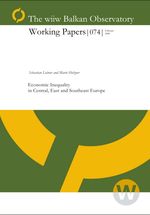Economic Inequality in Central, East and Southeast Europe
Mario Holzner and Sebastian Leitner
wiiw Balkan Observatory Working Paper No. 74, February 2008
The article analyses the issue of economic inequality in the transition economies of Central, East and Southeast Europe. It consists of a literature review and a descriptive analysis as well as an econometric modelling exercise. In the fi rst part we point at the fact that the rise in income inequality was triggered by the magnitude of transitional output loss and a reduction of formal employment. Rising wage inequality was at the core of total income dispersion, while government transfers had a redistributional function only in Central and Southeast European countries contrary to the Commonwealth of Independent States (CIS). In the econometric analysis it is found that for instance public utilities infrastructure liberalisation has increased inequality in transition, while price and trade liberalisation has decreased it. A high share of employment in industry and high government expenditures are connected with less inequality.
Keywords: income distribution, inequality, transition economies
JEL classification: D63, O15, P36
Countries covered: Central, East and Southeast Europe, CESEE
Research Areas: Labour, Migration and Income Distribution
